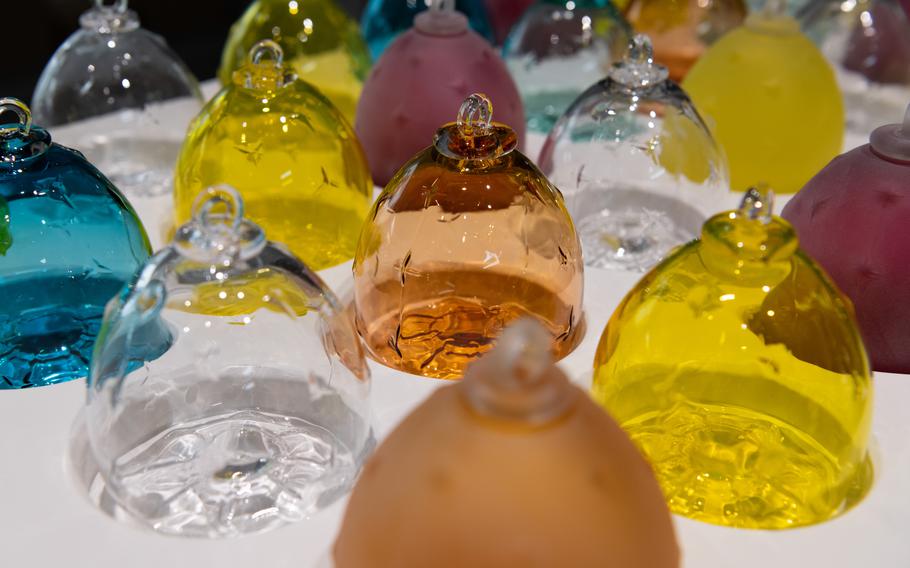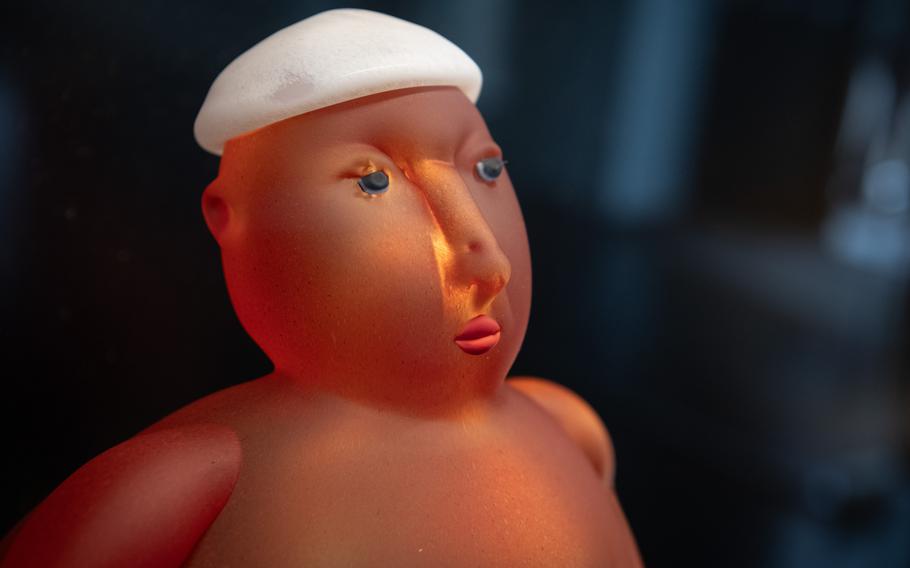
Handblown glass Christmas ornaments from 2024 for sale at Meisenthal Glassworks in Meisenthal, France. Each year, the facility designs a new ornament, which is highly sought-after. (Phillip Walter Wellman/Stars and Stripes)
If you ask staff at Meisenthal Glassworks in northeastern France why the site is closed to the public during the first three months of the year, they’ll tell you they need that long to recover from the Christmas rush.
Each winter, tens of thousands of people descend on the tiny village of Meisenthal a little more than an hour’s drive from the Kaiserslautern Military Community to buy handblown glass Christmas ornaments.
The glassworks releases a newly designed ornament each holiday season, and because its wares aren’t sold online, customers must buy them in person, sometimes waiting in line for up to three hours.
But those who come before the holiday rush, when the pace is slower, will find more than souvenirs.
Between April and October, visitors can check out live glassblowing demonstrations, museum exhibits and hands-on workshops. Come November, the sole focus at the glassworks is on making and selling the Christmas ornaments.
Zelia Collot works in cultural outreach at the facility, known in French as the Site Verrier Meisenthal. During my recent visit, she shared a wealth of insights into the operation.
“When people come here, they understand glass — how you can make it, how you can work it — and how important it has been to this area,” Collot said.
From an elevated observation area of the International Center for Glass Art, known by the French abbreviation CIAV, visitors can watch craftsmen shape molten glass into objects, while they periodically explain the process to onlookers.
Demonstrations are in French, but they’re easy to follow even with little or no knowledge of the language. English-speaking guides are available by advance reservation and can assist with translation if desired.
Visitors can also access a free digital guide in English by scanning a QR code on site. It provides information on all areas of the glassworks.
The opening of the CIAV in 1992 marked the start of a revival of glassblowing in Meisenthal after decades of dormancy. The goal wasn’t mass production, but the preservation of traditional techniques and the training of a new generation of glassmakers.
Since at least the Middle Ages, artisans have used the area’s silica-rich sandstone, potash, wood and water to make glass. Meisenthal’s factory began operating in 1711, part of a growing network of glassworks in the area.
In the 20th century, though, the rise of plastic, shifts in global trade and high energy costs contributed to the decline of the traditional glassworks. Meisenthal’s factory closed in 1969.
Nowadays, the CIAV is the heart of the glassworks. In addition, the site includes a glass museum featuring technical displays and touchable objects that explain traditional production methods.
Visitors can also see a collection of works by Émile Gallé, a pioneer of French Art Nouveau who collaborated with Meisenthal glassmakers in the mid-1800s, as well as pieces by modern artists.
The third component of the glassworks is the Glass Hall, a towering brick-and-steel structure built in the early 20th century. Once used in production, it now hosts concerts, exhibitions and other events.
The space can accommodate up to 3,000 spectators despite retaining two large glassmaking furnaces that are no longer used. Swedish musician Eagle-Eye Cherry, known for his 1997 hit “Save Tonight,” is scheduled to perform there in October.
For those eager to explore more of the region’s glassmaking legacy, Meisenthal is one of three stops along the Étoiles Terrestres, or Earthly Stars, glass route. The other two are the Saint-Louis crystal works in Saint-Louis-les-Bitche and the Lalique Museum in Wingen-sur-Moder.
Monuments to glass production can also be found in nearby villages, including Lemberg and Goetzenbruck, which is credited with starting France’s glass ornament tradition in the 19th century.
At the time, apples were commonly used to decorate Christmas trees. But a poor harvest one year is said to have inspired Goetzenbruck glassblowers to create glass apples to hang on the trees instead.
By the late 1800s, the village had become France’s leading producer of holiday ornaments. Over time, Goetzenbruck’s factory shifted to industrial glass used in watches and glasses, and the handmade ornament tradition gradually faded.
It might have disappeared entirely if not for several former Goetzenbruck glassblowers who in the 1990s passed on their knowledge to a new generation of artisans in Meisenthal.
The ornaments that draw most people are only the most visible part of a much older story. People who head to Meisenthal for more than just Christmas commercialism will find a village that’s keeping its past alive, one piece of glass at a time.

Glass art by Giampaolo Amoruso is on display at the Glass Museum, part of Meisenthal Glassworks in Meisenthal, France. (Phillip Walter Wellman/Stars and Stripes)
Meisenthal Glassworks
Address: Place Robert Schuman, Meisenthal, France
Hours: Glassworks (except for special events at the Glass Hall) April 1-Oct. 19 and November through the end of the year, Tuesday-Sunday, 1:30 p.m. to 6 p.m.
Cost: Full adult price, 9 euros; students, people with disabilities, 4.50 euros; children 6-17, 4 euros; children under 6, free; family/day pass, 18 euros; adult annual pass, 12 euros; annual pass for children 6-17, 7 euros.
Information: https://ciav-meisenthal.fr/accueil; +33 3 87 96 81 22; contact@site-verrier-meisenthal.fr